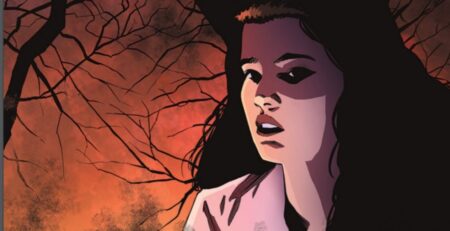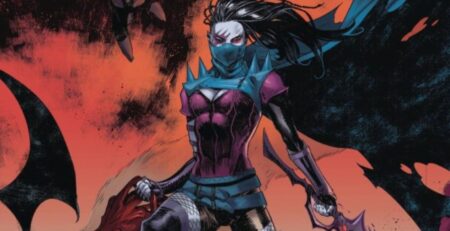
World Class is an original graphic novel published by Mad Cave Studios. Jay Sandlin writes this sports comic with art by Patrick Mulholland. Rebecca Nalty is the colourist, and the letters are by Justin Birch. Adrian Molina, the son of a hardworking but poor family, is a young and upcoming football star in Colombia. He dreams of playing in the pro leagues in Europe, with his powerful leg driving him to victory. However, he receives an offer to play for Regents United, a very posh and successful team in England. Adrian travels thousands of miles to be enrolled in a very different school than he is used to while proving himself on the team. But with a fierce and talented rival, that will not be easy.
The plot of World Class is engaging and exciting. The premise is simple but engaging as Sandlin introduces a fish-out-of-water story. The sense of adversity that the main character faces is intense from the beginning to the finale, giving Molina a grueling mountain to climb. The writer does a brilliant job of combining the sports aspect of the plot and some of the irregular challenges teenagers face in their lives. This comic excels during the football matches themselves. The thrill of the beautiful game is captured even in a static form. While many of the outcomes may be predictable, there are still plenty of welcome surprises.
What makes this graphic novel shine is the excellent characters at its disposal. There is a wealthy cast, all with a superb presence on the page. As a protagonist, Adrian is fantastic. He is instantly likable. The most endearing part about him is that Adrian isn’t a perfect character or even a perfect footballer at all. At the beginning of his journey, he has a cannon of a foot but cannot find the goal. So he has to be taught. Striving to become great makes his achievements so much more impressive.
The other club members are all given facets that make them interesting characters. From the goalie to the defenders, the understanding that the whole team needs some development is key. One of the most enjoyable characters in World Class is Luciano. He is a team member and acts as the cool head inside all of the egos. When Molina is bullied at the beginning of his stint, Luciano offers to help. He is a mentor to Adrian, taking him under his wing and offering tactical advice on the pitch. The relationship between the friends is incredibly written.
As a rival, Titan is also great. He is a remarkable talent but an untouchable brute due to his parents donating to the school. As the antithesis to the protagonist, he serves as a brilliant target for Molina to try and knock off his pedestal. What stands in their way is the fact that they are teammates, meaning that working together is essential to success. The only criticism of the characters is that national stereotypes are leaned on a little too heavily with some of the commentators.
The dialogue is crucial to this comic because the football matches and the action need help being described at points. This is done superbly without stepping over the art. There are some fascinating pearls of wisdom when the team is being trained. A minor part that needs to be mentioned is the use of American terms for the English game. The creators do not fall into the trap of having a soccer/football argument by not mentioning either word. But, “extra time” and “passes” are replaced with “overtime” and “plays.” It is understandable why the change is made to provide recognisable concepts to American readers, but it was strange to see the English characters refer to them.
The art is brilliant. Mulholland on the line art mirrors the plot’s energy and the characters. Each character has a unique design, even to the detail of being a different body shape. From just a silhouette, the individuals are instantly recognisable. The lines are clean and smooth, allowing the reader to see what is happening clearly. The matches themselves capture the motion and power of the strikes and tackles, with motion lines utilised frequently. The reader is left eagerly waiting for the next game.
The matches take place in real, existing stadiums. These are iconic arenas, from the Signal Iduna Park in Dortmund to the Camp Nou in Catalonia. The stadiums and their signature architecture are captured superbly by Mulholland, creating a flutter in the chest of football fans.
Perhaps the most affecting downside of the art has to do with the panel layout. Many of the pages, particularly once the comic commences, are structured to be read down, then across. Doing it in this method gives a verticality to the comic, but it can be confusing for the eye to follow. Similarly, some of the big double pages have some perplexing layouts.
The colours are fantastic. Nalty implements a vibrant style to World Class, with some stunning shades used in the foreground. Every respective team has a unique colour that makes them stand out. The backgrounds are frequently solid, single tones, sometimes including subtle gradients. This helps the cleanliness of the overall look. The lettering is similarly excellent. The word balloons and the text are large and effortless to read.
World Class is an exciting sport comic for young adults. There is such an exhilarating power to the story and the characters that the reader very quickly warms and grows to care for them. Where Roy of the Rovers or Ball Boy from The Beano showcased football culture in England, Sandlin showcases how wide-ranged this sport is. And on the whole, it succeeds with some riveting matches. It could also be very easily be adapted into other formats.
World Class is available where comics are sold from February 22nd.
World Class
TL;DR
World Class is an exciting sport comic for young adults. There is such an exhilarating power to the story and the characters that the reader very quickly warms and grows to care for them…Sandlin showcases how wide-ranged this sport is. And on the whole, it succeeds with some riveting matches.






